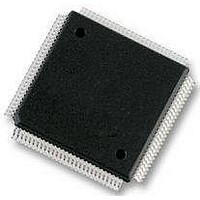MC912D60CCPVE Freescale Semiconductor, MC912D60CCPVE Datasheet - Page 196

MC912D60CCPVE
Manufacturer Part Number
MC912D60CCPVE
Description
IC MCU 16BIT 112-LQFP
Manufacturer
Freescale Semiconductor
Series
HC12r
Datasheet
1.MC912D60ACFUE8.pdf
(460 pages)
Specifications of MC912D60CCPVE
Core Processor
CPU12
Core Size
16-Bit
Speed
8MHz
Connectivity
CAN, MI Bus, SCI, SPI
Peripherals
POR, PWM, WDT
Number Of I /o
68
Program Memory Size
60KB (60K x 8)
Program Memory Type
FLASH
Eeprom Size
1K x 8
Ram Size
2K x 8
Voltage - Supply (vcc/vdd)
4.5 V ~ 5.5 V
Data Converters
A/D 16x8/10b
Oscillator Type
Internal
Operating Temperature
-40°C ~ 85°C
Package / Case
112-LQFP
Processor Series
HC912D
Core
HC12
Data Bus Width
16 bit
Data Ram Size
2 KB
Interface Type
CAN, SCI, SPI
Maximum Clock Frequency
8 MHz
Number Of Programmable I/os
86
Maximum Operating Temperature
+ 85 C
Mounting Style
SMD/SMT
3rd Party Development Tools
EWHCS12
Minimum Operating Temperature
- 40 C
On-chip Adc
10 bit, 8 Channel
Lead Free Status / RoHS Status
Lead free / RoHS Compliant
Available stocks
Company
Part Number
Manufacturer
Quantity
Price
Company:
Part Number:
MC912D60CCPVE
Manufacturer:
FREESCAL
Quantity:
203
Company:
Part Number:
MC912D60CCPVE
Manufacturer:
Freescale Semiconductor
Quantity:
10 000
- Current page: 196 of 460
- Download datasheet (5Mb)
Oscillator
12.5.1.1 Oscillator Architecture Change from Colpitts to Pierce
Technical Data
196
The primary difference from the ‘A’ to the ‘P’ versions of the
MC68HC912D60 is the architecture, or configuration, of the oscillator.
The previous version (‘A’) is connected in Colpitts configuration, where
the resonator is connected between the EXTAL pin and VSS. This
configuration causes the relatively large parasitics from EXTAL to VSS
react in parallel with the resonator, decreasing gain margin in some
corners. The Pierce configuration places the much-lower EXTAL to
XTAL parasitic capacitances in parallel with the resonator, providing a
much larger gain margin across process, temperature and voltage
variance.
Implementation of the Pierce architecture required the replacement of
the previous P-type, non-inverting source-follower amplifier with an N-
type, inverting, traditional amplifier. Additionally, the EXTAL biasing
circuit on the Colpitts configurations was replaced with a feedback
resistor from XTAL to EXTAL to achieve self-bias. Parametric
differences from the ‘A’ to the ‘P’ versions of the oscillator include:
•
•
•
•
The input ESD resistor from EXTAL to the gate of the oscillator
amplifier was changed to provide a parallel path, reducing
parasitic phase shift in the oscillator.
Phase shift from EXTAL to XTAL — The phase shift on the ‘P’
version will be approximately 180 degrees (vs. approximately 0
degrees on the ‘A’ version) due to the requirement of an inverting
amplifier in the Pierce configuration).
DC offset of oscillation on EXTAL and XTAL — The DC offset of
the EXTAL and XTAL nodes on the ‘P’ version will be
approximately 0.7–1.0V (vs. approximately VDD–2V and
VDD–1V, respectively, on the ‘A’ version) due to the different bias
requirements of the N-type inverting amplifier.
Amplitude of oscillation — The amplitude of oscillation may be
slightly lower on the ‘P’ version than the ‘A’ version due to using
the same Amplitude Level Control (ALC) circuit for both
architectures. The circuit responds slightly differently to the
different DC offsets in the two architectures, resulting in slightly
Oscillator
MC68HC912D60A — Rev. 3.1
Freescale Semiconductor
Related parts for MC912D60CCPVE
Image
Part Number
Description
Manufacturer
Datasheet
Request
R
Part Number:
Description:
Manufacturer:
Freescale Semiconductor, Inc
Datasheet:
Part Number:
Description:
Manufacturer:
Freescale Semiconductor, Inc
Datasheet:
Part Number:
Description:
Manufacturer:
Freescale Semiconductor, Inc
Datasheet:
Part Number:
Description:
Manufacturer:
Freescale Semiconductor, Inc
Datasheet:
Part Number:
Description:
Manufacturer:
Freescale Semiconductor, Inc
Datasheet:
Part Number:
Description:
Manufacturer:
Freescale Semiconductor, Inc
Datasheet:
Part Number:
Description:
Manufacturer:
Freescale Semiconductor, Inc
Datasheet:
Part Number:
Description:
Manufacturer:
Freescale Semiconductor, Inc
Datasheet:
Part Number:
Description:
Manufacturer:
Freescale Semiconductor, Inc
Datasheet:
Part Number:
Description:
Manufacturer:
Freescale Semiconductor, Inc
Datasheet:
Part Number:
Description:
Manufacturer:
Freescale Semiconductor, Inc
Datasheet:
Part Number:
Description:
Manufacturer:
Freescale Semiconductor, Inc
Datasheet:
Part Number:
Description:
Manufacturer:
Freescale Semiconductor, Inc
Datasheet:
Part Number:
Description:
Manufacturer:
Freescale Semiconductor, Inc
Datasheet:
Part Number:
Description:
Manufacturer:
Freescale Semiconductor, Inc
Datasheet:











